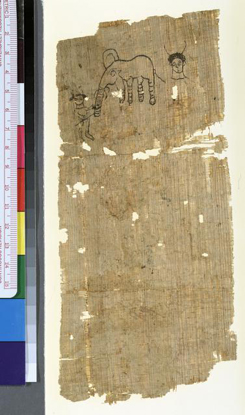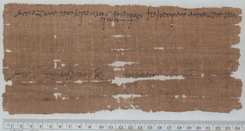 |
T A B L E O F C O N T E N T S
M A R C H / A P R I L 2 0 1 4
Volume 20, Number 3/4
doi:10.1045/march2014-contents
ISSN: 1082-9873
E D I T O R I A L
Acquisition and Preservation
Editorial by Laurence Lannom, Corporation for National Research Initiatives
A R T I C L E S
Participatory Cultural Heritage: A Tale of Two Institutions' Use of Social Media
Article by Chern Li Liew, Victoria University of Wellington, New Zealand
Abstract: The purpose of this study is to examine how and to what extent cultural heritage institutions (CHIs) are currently using social media to create a culture of participation around their digital collections and services. An environmental scan of New Zealand CHIs with a social media initiative was conducted and four cases with considerable activities, participatory communication and user-generated contents were investigated. Two of these case studies are reported in this paper. The two sites were chosen, firstly, on the basis of their having levels of participatory activity significant enough to merit in-depth analyses; and, second, on their ability to provide contrasting examples of different approaches and practices. The purpose of the comparison is to highlight the different nature and extent of participatory culture and user generated/contributed contents. While one of the sites belongs to a major national institution, the other represents a regional, community-level initiative. Further, while one site employs a self-hosted Web 2.0 platform, the other utilises a third-party platform. Finally, while one is aimed primarily at displaying and promoting images from an archival collection while enabling user commenting, the other actively seeks contributions to share and co-construct local history stories.
Digital Preservation File Format Policies of ARL Member Libraries: An Analysis
Article by Kyle Rimkus, Thomas Padilla, Tracy Popp and Greer Martin, University of Illinois at Urbana-Champaign
Abstract: Whether overseeing institutional repositories, digital library collections, or digital preservation services, repository managers often establish file format policies intended to extend the longevity of collections under their care. While concerted efforts have been made in the library community to encourage common standards, digital preservation policies regularly vary from one digital library service to another. In the interest of gaining a broad view of contemporary digital preservation practice in North American research libraries, this paper presents the findings of a study of file format policies at Association of Research Libraries (ARL) member institutions. It is intended to present the digital preservation community with an assessment of the level of trust currently placed in common file formats in digital library collections and institutional repositories. Beginning with a summary of file format research to date, the authors describe the research methodology they used to collect and analyze data from the file format policies of ARL Library repositories and digital library services. The paper concludes with a presentation and analysis of findings that explore levels of confidence placed in image, text, audio, video, tabular data, software application, presentation, geospatial, and computer program file formats. The data show that file format policies have evolved little beyond the document and image digitization standards of traditional library reformatting programs, and that current approaches to file format policymaking must evolve to meet the challenges of research libraries' expanding digital repository services.
Managing a National Health Repository
Article by Aoife Lawton and Padraig Manning, Health Service Executive, Ireland
Abstract: Institutional repositories are becoming part of mainstream scholarship in many academic libraries. Subject based repositories are well suited to disciplines such as the health sciences, where repositories are evolving rapidly. In Ireland, as in other countries, the healthcare sector produces a vast quantity of research and grey literature. This article examines how a national subject repository for Ireland's health services was established and managed by a Regional Library Service. It explores the rationale for the repository, established amid massive organizational change with a declared aim of preserving and promulgating Ireland's health literature in all its forms. Key to the success of the repository was involvement of health professionals from the outset and a continued dialogue with researchers within the healthcare system.
Preserving Web-based Auction Catalogs at the Frick Art Reference Library
Article by Gretchen Nadasky, Optimity Advisors
Abstract: The Frick Art Reference Library (FARL) has a collection of over 90,000 auction catalogs and they are one of the most requested resources at the library, as more auction houses are publishing on-line. FARL began the "Reframing Collections for a Digital Age" project to address the stability of born-digital art research materials. The first phase of the project identified the basic risks and determined that Archive-It software was the best means of capturing this information. The second phase, described in this paper, identified criteria to determine preservation priorities and evaluate what has already been captured by the Internet Archive, with the goal of creating a list of websites that can and should be harvested immediately. The study also examined the pilot seed crawl results which monitor quality of materials being collected.
O P I N I O N
BitTorrent and Libraries: Cooperative Data Publishing, Management and Discovery
Opinion by Chris Markman, Clark Univeristy and Constantine Zavras
Abstract: The evolution of Open Data depends on the use of new technologies that not only allow equal access to information, but equal access to the distribution and redistribution of public knowledge. An open API offers only the illusion of transparency—for data to truly be free, librarians must look towards their audience as digital collaborators, rather than simply end users. Thankfully, the tools to create a global, decentralized, peer-to-peer information network for massive amounts of data has been hiding under our nose the entire time. In this opinion piece we explore the opportunities afforded by the BitTorrent protocol. We also discuss what happens when libraries adopt a distributed, grassroots approach to data management that saves money and lays the groundwork for online community.
C O N F E R E N C E R E P O R T S
Report on the Capability Assessment and Improvement Workshop (CAIW) at iPres 2013
Conference Report by Christoph Becker, University of Toronto and Vienna University of Technology and Elsa Cardoso, University Institute of Lisbon and INESC-ID
Abstract: While Digital Preservation is making progress in terms of tool development, progressive establishment of standards and increasing activity in user communities, there is a lack of approaches to systematically assessing, comparing and improving how organizations go about achieving their preservation goals. This currently presents a challenge to many organizations for whom digital stewardship is a concern and reveals a substantial gap between theory and practice. To provide an interactive, focused venue for those interested in systematic approaches for assessment and improvement, we organized the first Capability Assessment and Improvement Workshop (CAIW) in Lisbon, on September 5, 2013, as part of the 10th International Conference on Digital Preservation (iPres 2013). This article provides a report on the issues discussed and attempts to synthesize the main conclusions with the intention of stimulating further discussion in the community on this topic.
Report on the 2nd International Workshop on Historical Document Imaging and Processing (HIP'13)
Conference Report by George V. Landon, Eastern Kentucky University
Abstract: The second International Workshop on Historical Document Imaging and Processing (HIP'13) was held August 24, 2013 in Washington DC, USA, in conjunction with the International Conference on Document Analysis and Recognition (ICDAR 2013). The workshop, which brought together an international group of researchers who work with historical documents, was complementary and synergistic to the work in analysis and recognition featured in the main ICDAR sessions. Technical areas covered in the workshop included information extraction and retrieval; reconstruction and degradation; text and image recognition and segmentation; and layout analysis and databases. The researchers, many with computer and engineering backgrounds, shared their ongoing work in building tools and methods to handle the digitization of historical documents.
N E W S & E V E N T S
In Brief: Short Items of Current Awareness
In the News: Recent Press Releases and Announcements
Clips & Pointers: Documents, Deadlines, Calls for Participation
Meetings, Conferences, Workshops: Calendar of Activities Associated with Digital Libraries Research and Technologies
|
 |
F E A T U R E D D I G I T A L
C O L L E C T I O N

University of Michigan Advanced Papyrological Information System (APIS)

Unknown author. [Letter + drawing.] P. Mich.inv. 4290, recto. (V/VI century A.D.)
[Image digitally reproduced with the permission of the Papyrology Collection, Graduate Library, University of Michigan.]

Paniskos. [Letter sent by Paniskos to his wife Ploutogenia, requesting
her to come to Koptos.] P.Mich.inv. 1367, verso. (ca. 296-297 A.D.)
[Image digitally reproduced with the permission of the Papyrology Collection, Graduate Library, University of Michigan.]
In ancient times, a writing material made from the papyrus plant was used in Egypt and throughout the Mediterranean region to create documents. Some of these documents have survived for millennia, and they are vital for historical research; however, the materials are extremely fragile, which has limited their use in physical form. To overcome this obstacle, in 1991 the University of Michigan began using new technologies to digitize the university's large collection of papyri. This work resulted in the University of Michigan Advanced Papyrological Information System (APIS).
The University of Michigan led the way in establishing the digitization project hoping that other universities would follow suit. In 1993, through the initiative of Professor Roger Bagnall at Columbia University, the American Society of Papyrologists became involved in the effort and created a technology committee to oversee and coordinate such projects, as well as to set methodology and standards for image capture and cataloging. This was the birth of the APIS.
APIS is a "virtual library" that provides online access to papyrological collections enabling users to view digital images and detailed catalog records containing information on papyrus characteristics, corrections to published papyri, and republications. Of keen interest to historians, linguists, classicists, philosophers, archaeologists, as well as others, the collection includes biblical fragments, religious writings, public and private documents, private letters, and writings on astronomy, astrology, mathematics, and magic. The papyri give users a glimpse into ancient societies (two millennia of history, dating from about 1000 BC to AD 1000), as nothing else can.
D - L I B E D I T O R I A L S T A F F
Laurence Lannom, Editor-in-Chief
Allison Powell, Associate Editor
Catherine Rey, Managing Editor
Bonita Wilson, Contributing Editor
|